


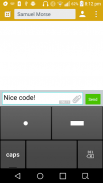
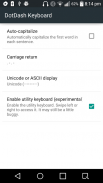
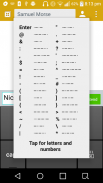
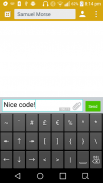
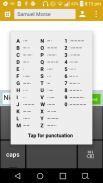
DotDash Keyboard

Descrizione di DotDash Keyboard
Are you looking for an on-screen keyboard that will work with your phone's small screen and slow CPU? Do you know or are you willing to learn Morse code? If you answered "yes" to both of these questions, then this may be the keyboard for you!
IMPORTANT: This is an "Input Method", also known as a "soft keyboard" or IME. It acts as a replacement for the default Android on-screen keyboard. As such, it doesn't show up in your applications list. Instead, after installing it you will need to go to your phone's "Language & keyboard" settings screen and tick the checkbox next to "DotDash Keyboard" to activate it. Then, (if you're using Android 2.3 or less) long-press in any text field (such as the "To" field of a text message), and in the menu that pops up select "Input method". Then choose "DotDash Keyboard" from the list.
DotDash Keyboard is an Input Method, a drop-in replacement for Android's on-screen keyboard. It allows you to enter text via Morse code, using three main buttons: Dot, Dash, and Space (as well as Shift and Delete).
- Type a letter by entering its series of dots and dashes
- Press Space to end a letter and move on to the next one
- Press Space twice to insert a space between words
- Press Delete to clear the letter in progress, or delete the last letter typed if there is no letter in progress
- Type the symbol ".-.-" for the Enter key
- Swipe up off the keyboard for a Morse code cheat sheet
FREQUENTLY ASKED QUESTIONS:
Q: Isn't this an awful lot like that "Gmail Tap" April Fool's Day joke?
A: It is quite similar, but it's no joke. This is a real, working on-screen keyboard which I've been using full time on my cheapo phone since February 2012. Imagine my surprise when my personal software project was perfectly replicated two months later in Google's April Fool's Day video, right down to my rationale for designing it! I was planning to add a few more features before releasing it, but the video made me decide to publish this sparse but fully functional version ahead of schedule.
Q: This is nothing like the setup I use for ham radio.
A: No it isn't. Sorry! I'd like to add some more ham-friendly features, such as audio feedback, and timing-based input using one paddle, two paddles, and/or iambic, but I haven't gotten there yet.
Q: But really, why three buttons instead of just one?
A: This was actually a design decision. Not only does my phone have a tiny screen, it also has a very slow CPU. I found that input methods based on drawing on screen (or other usage of timing) frequently screwed up when my phone's CPU would bog down. By having a separate button for dot, dash, and space, it doesn't matter how slow the phone processes things, as long as it eventually registers each screen tap in the correct sequence.
Q: Can I switch back and forth between this and my original keyboard?
A: Sure! Just go to your phone's "Language & keyboard" screen and make sure both keyboards are ticked. Then, long-press in any text field and bring up the "Input method" menu again. This will let you switch back and forth as much as you want.
Q: I still don't like it!
A: Well, if you search Google Play for "morse code keyboard" or "morse code IME", you'll find several other Morse code soft keyboards. They're each slightly different, so one of them might suit you. If you don't want to learn Morse code but like the idea of reducing the number of buttons on your keyboard, consider trying a T9 keyboard. That's the numeric keypad old cell phones had. There are several on-screen versions of T9 in Google Play, or your phone may even have shipped with one.
Q: Are you sure this isn't a joke? It doesn't show up in my applications list.
A: This is an "Input Method", and so it doesn't show up in your applications list. See the note labelled "IMPORTANT" at the top of this description for setup instructions.Sei alla ricerca di una tastiera su schermo che funziona con lo schermo piccolo del telefono e CPU lenta? Sapete o siete disposti a imparare il codice Morse? Se avete risposto "sì" a entrambe le domande, allora questo potrebbe essere la tastiera per voi!
IMPORTANTE: Questa è una "Input Method", noto anche come "tastiera virtuale" o IME. Esso agisce come un sostituto per il default Android tastiera su schermo. Come tale, essa non compare nella lista delle applicazioni. Invece, dopo averlo installato è necessario per passare alla schermata del telefono "Lingua e tastiera" Impostazioni e selezionare la casella accanto a "DotDash Tastiera" per attivarlo. Poi, (se si sta utilizzando Android 2.3 o meno) premere a lungo in qualsiasi campo di testo (ad esempio il campo "A" di un messaggio di testo), e nel menu che si apre selezionare "Metodo di inserimento". Quindi scegliere "DotDash Keyboard" dalla lista.
DotDash Keyboard è un metodo di input, un rimpiazzo per la tastiera su schermo di Android. Esso consente di inserire il testo tramite il codice Morse, utilizzando tre principali pulsanti: Dot, Dash, e spazio (oltre che di spostamento e cancellazione).
- Digitare una lettera inserendo la sua serie di punti e linee
- Premi la barra spaziatrice per terminare una lettera e passare a quello successivo
- Premi la barra spaziatrice due volte per inserire uno spazio tra le parole
- Premere il tasto Canc per cancellare la lettera in corso, o eliminare l'ultima lettera digitata se non vi è nessuna lettera in corso
- Digitare il simbolo per il tasto Invio "-.-."
- Scorrere fino al largo della tastiera per un codice cheat sheet Morse
DOMANDE FREQUENTI:
D: Non è questo un lotto terribile come Giorno scherzo che "Gmail Tap" Aprile del Matto?
R: E 'molto simile, ma non è uno scherzo. Si tratta di un vero e proprio, lavorando sulla tastiera a schermo che ho usato a tempo pieno sul mio telefono cheapo dal febbraio 2012. Immaginate la mia sorpresa quando il mio progetto software personale era perfettamente replicato due mesi dopo, nel giorno il video del Pesce d'Aprile di Google, fino al la mia logica per la progettazione di esso! Avevo intenzione di aggiungere qualche funzionalità prima di rilasciarlo, ma il video mi ha fatto decidere di pubblicare questa versione scarsa ma completamente funzionale prima del previsto.
D: Questo è niente come la configurazione che uso per radioamatori.
A: No, non è. Siamo spiacenti! Mi piacerebbe aggiungere un po 'più caratteristiche prosciutto-friendly, come il feedback audio e ingresso di temporizzazione-based utilizzando una pagaia, due pale, e / o giambico, ma non ho ottenuto ancora lì.
D: Ma in realtà, perché tre pulsanti invece di uno solo?
R: Questo era in realtà una decisione di progettazione. Non solo il mio telefono ha un piccolo schermo, ha anche una CPU molto lenta. Ho trovato che i metodi di input basati su disegnare sullo schermo (o altro uso dei tempi) spesso avvitato quando la CPU del mio telefono sarebbe impantanarsi. Avendo un pulsante separato per punti, trattino e spazio, non importa quanto lento i processi telefonici cose, fintanto che casualmente registra ogni tocco dello schermo nella sequenza corretta.
D: Posso passare avanti e indietro tra questo e la mia tastiera originale?
A: Certo! Basta andare alla schermata "Lingua e tastiera" del telefono e assicurarsi che siano selezionate entrambe le tastiere. Poi, premere a lungo in qualsiasi campo di testo e il menu "Metodo di inserimento" di nuovo. Questo vi permetterà di passare avanti e indietro tanto quanto si desidera.
Q: Io ancora non mi piace!
A: Beh, se si cerca Google Play per "tastiera morse code" o "codice morse IME", troverete molte altre tastiere morbido Codice Morse. Sono ogni leggermente diverso, così uno di loro potrebbe fa per voi. Se non si desidera imparare il codice Morse, ma piace l'idea di ridurre il numero di tasti sulla tastiera, prendere in considerazione cercando una tastiera T9. Questo è il tastierino numerico vecchi cellulari avevano. Ci sono diverse versioni su schermo di T9 in Google Play, o il telefono può anche essere fornito con uno.
Q: Sei sicuro che questo non è uno scherzo? Essa non compare nella mia lista delle applicazioni.
R: Si tratta di un "metodo di input", e quindi non si presenta nella lista delle applicazioni. Vedere la nota etichetta "IMPORTANTE" nella parte superiore di questa descrizione per le istruzioni di configurazione.
























